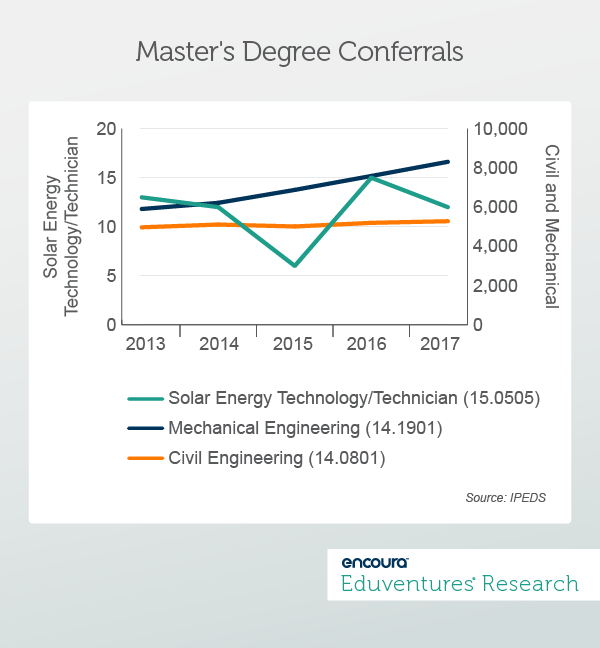Drawing on Eduventures’ 20-plus years of experience helping universities develop, launch, and assess academic programs, the Program Spotlight Series of Wake-Up Calls calls attention to best practices in program development.
Smart higher education institutions are constantly retooling their academic portfolios to capture evolving student interests, meet future workforce needs, and get a jump on the next big degree program. As a research partner to many of them, new and unique programs that pop up close to home are bound to catch our attention.
Tufts University (Tufts) did just that when it launched a Master of Science in Offshore Wind Energy Engineering, positioned as first-of-its-kind. Trends suggest strong growth and a promising future for this emerging industry -
Let’s consider some of the factors.
Industry trends and external forces in Tufts’ region suggest a promising market opportunity.
The U.S. wind energy capacity is projected to make massive gains over the next 30 years. In fact, the Department of Energy projects that wind energy could meet one-third of the country’s energy needs by the year 2050. That represents a more than four-fold increase from today’s capacity (Figure 1).

On a national level, major corporations are increasingly turning to renewable energy. Facebook’s 2018 pledge to consume 100% renewable energy by 2020 and Starbucks’ initiative to run 10,000 stores off wind and solar energy by 2025 are two examples.
Regionally, in May 2018, Massachusetts announced a project to bring offshore wind energy to the state. The procurement of 800 megawatts of offshore wind energy is the single largest made by any state in the U.S. thus far, signaling that Massachusetts may become a hub for this emerging industry. Reports indicate that rights to establish the wind farms represent the potential for the largest offshore windfarm in the world.
The occupational outlook, however, sends mixed signals.
The clean energy sector employed more than 10 million people around the world for the first time in 2018. Wind energy accounts for the second most jobs behind the solar sector with 1.15 million jobs (84% of which are based in North America, Europe, or China).
Bureau of Labor Statistics (BLS) data reveals that two clean energy-aligned occupations are projected to be the fastest growing occupations in the U.S. (Table 10).
Table 1. Projected Growth for Clean-Energy Occupations
| Occupation | 2018 Jobs | 2028 Jobs | % Growth |
|---|---|---|---|
| Solar Photovoltaic Installers | 10,692 | 20,212 | 89% |
| Wind Turbine Service Technicians | 5,398 | 10,199 | 89% |
A master’s in offshore wind energy engineering might be well-suited to tap into the growing demand for wind turbine service technicians, right? Not necessarily. Neither of these occupations—solar photovoltaic installers nor wind-turbine service technicians—require a college degree.
In fact, the typical entry-level education requirement for wind turbine service technicians is a postsecondary non-degree award. And, while the 2018 Massachusetts Clean Energy Industry Report indicates that installation-related jobs will be the largest source of employment in this sector, it’s more likely that civil, environmental, and mechanical engineers are more realistic occupations for an engineering program graduate (Table 2).
Table 2. Projects Growth for Engineering Occupations
| Occupation | 2018 Jobs | 2028 Jobs | % Growth |
|---|---|---|---|
| Civil Engineers | 301,768 | 337,527 | 12% |
| Environmental Engineers | 55,269 | 60,925 | 10% |
Given that the national projected growth for all jobs from 2018-2028 is 10%, these wind energy-aligned occupations highlighted above may not be as fast-growing as they initially appear.
While demand for this specialized program remains to be seen, it won’t experience much direct program competition at first.
As confirmation of its novelty, there is no Classification of Instruction Program (CIP) code for wind or offshore wind engineering, which makes it challenging to examine this market. There is, however, a CIP code for Solar Energy Technology/Technician which may shed light on how extremely specialized, clean energy-aligned programs are performing.
Since 2013, master’s degrees in mechanical engineering have experienced solid growth (9%) and civil engineering master’s degrees have seen slight growth (1.5%). The Solar Energy Technology/Technician master’s degree market, however, appears to be very small, volatile, and ultimately experiencing a decline in conferrals (-2%), see Figure 2. Note that the single program reporting to this CIP code is Arizona State University’s Master of Science in Solar Energy Engineering and Commercialization.

Tufts’ master’s in offshore wind energy does appear to be the first stand-alone engineering master’s degree program focused on wind energy. A number of schools offer educational opportunities, typically in the form of courses, research opportunities, and special projects that touch on wind energy, but none offer standalone programs. Examples include the University of Kansas’ wind turbine engineering course, offered as part of its aerospace engineering program, and the University of Maine’s renewable energy engineering minor, which includes wind energy curriculum options.
The Bottom Line
So, is wind energy “the next big program?” Chances are, no. Despite broad, positive market indicators for this sector, student demand for such a niche focus of study may be limited. Likely, a more general engineering program, with curriculum tracks providing academic and training opportunities designed around wind energy, might ultimately attract more student interest.
Was Tufts on the right track, though? Likely, yes. It seems that Tufts’ program may benefit from the unique regional conditions that may not exist for other schools. Given the state’s recent investment in wind energy, the necessary building block may be in place for this program to take off, but it may not be there for a school located somewhere else.
We are pleased and proud to announce that Bill Belichick, head coach of the New England Patriots, Six-time Super Bowl Champions, has joined the lineup of keynote speakers for Eduventures Summit, June 5 – 7th in Boston. For more information, a preliminary agenda, hotel information and registration link, click the link below!
